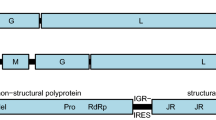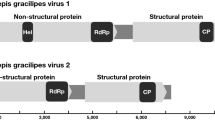Summary
The evolutionary relationship between socially parasitic ants and their hosts is still an unsolved problem. We have compared a 1.2 kb sequence of the 18 S ribosomal RNA genes of the parasitic antsDoronomyrmex kutteri, Harpagoxenus sublaevis andChalepoxenus muellerianus to the sequence of the host speciesLeptothorax acervorum andL. recedens (all subfamily Myrmicinae, tribe Leptothoracini) and to an out-group antCamponotus ligniperda (Formicinae). We found that parasitic species and the host species and alsoCamponotus ligniperda differ at less than 1% of the base positions of the 1.2 kb segment of the 18S rRNA gene. The sequences showed 80.3% identity to the 18 S ribosomal RNA genes of the beetleTenebrio molitor and only 66.5% to that of the dipteranDrosophila melanogaster.
Similar content being viewed by others
References
Abele, L. G., W. Kim and B. E. Felgenhauer, 1989. Molecular evidence for inclusion of the phylum Pentastomida in the Crustacea.Mol. Biol. Evol. 2:124–131.
Buschinger, A., 1974. Experimente und Beobachtungen zur Gründung und Entwicklung neuer Sozietäten der sklavenhaltenden AmeiseHarpagoxenus sublaevis (Nyl.).Ins. Soc. 21:381–406.
Buschinger, A., 1981. Biological and systematic relationship of social parasiticLeptothoracini from Europe and North America. In:Biosystematics of Social Insects (P. E. Howse and J. -L. Clément, eds.), Academic Press, London and New York,19:211–222.
Buschinger, A., 1987. Biological arguments for a systematic rearrangement of the Ant tribeLeptothoracini. In:Chemistry and Biology of Social Insects (J. Eder and H. Rembold, Eds.), Verlag J. Peperny, München.
Buschinger, A., 1990. Sympatric speciation and radiative evolution of socially parasitic ants — Heretic hypotheses and their factual background.Z. Zool. Syst. Evolut.-forsch. 28:241–260.
Chan, Y. L., R. Guteil, N. F. Noller and I. G. Wool, 1984. The nucleotide sequence of a rat 18 S ribosomal ribonucleic acid gene and a proposal for the secondary structure of 18 S ribosomal ribonucleic acid.J. Biol. Chem. 259:224–230.
Emery, C., 1909. Über den Ursprung der dulotischen, parasitischen und myrisen.Biol. Centralbl. 29:352–362.
Heinze, J., 1991. Biochemical studies on the relationship between socially parasitic ants and their hosts.Biochem. Syst. Ecol. 19:195–206.
Hendriks, L., R. De Baere, C. van Broekhoven and R. de Wachter, 1988a. Primary and secondary structure of the 18 S ribosomal RNA of the insect speciesTenebrio molitor.FEBS Lett. 232:115–120.
Hendriks, L., C. van Broekhoven, A. Vandenberghe, Y. van de Peer and R. de Wachter, 1988b. Primary and secondary structure of the 18 S ribosomal RNA of the bird spiderEurypelma californica and evolutionary relationships among eukaryotic phyla.Eur. J. Biochem. 177:15–20.
Hölldobler, B. and E. O. Wilson, 1990.The Ants. The Belknap Press of Harvard University Press; Cambridge, Mass.
Keohavong, P. and W. G. Thilly, 1989. Fidelity of DNA polymerase in DNA amplification.Proc. Natl. Acad. Sci. USA 86:9253–9257.
Kwok, S. and R. Higuchi, 1989. Avoiding false positives with PCR.Nature 339:237–238.
Lane, D. J., B. Pace, G. J. Olsen, D. A. Stahl, M. L. Sogin and N. R. Pace, 1985. Rapid determination of 16 S ribosomal sequences for phylogenetic analysis.Proc. Natl. Acad. Sci. USA 82:6955–6959.
Marchuk, D., M. Drumm, A. Saulino and F. S. Collins, 1991. Construction of T-Vectors a rapid and general system for direct cloning of unmodified PCR products.Nucleic Acid Res. 19:1154.
Olsen, G. J., N. Larsen and C. R. Woese, 1991. The ribosomal RNA database project.Nucleic Acid Res. 19:2017–2018.
Saiki, R. K., S. Scharf, F. Faloona, K. B. Mullis, G. T. Horu, H. A. Erlich and N. Arnheim, 1985. Enzymatic amplification of β-globin sequences and restriction site analysis for diagnosis of sickle cell anemia.Science 230:1350–1354.
Sambrook, J., E. F. Fritsch and T. Maniatis, 1989.Molecular cloning-a Laboratory Manual- Second Edition: Cold Spring Harbor Laboratory Press.
Sanger, F., S. Nicklen and M. Coulson, 1977. DNA sequencing with chain terminating inhibitors.Proc. Natl. Acad. Sci USA 162:5463–5467.
Singer, S. and P. Berg, 1991.Genes and Genomes. Blackwell, Oxford, pp. 631–636.
Tautz, D., J. M. Hancock, D. A. Webb, C. Tautz and G. A. Dover, 1988. Complete sequences of the rRNA genes ofDrosophila melanogaster.Mol. Biol. Evol. 5:366–376.
Torczynski, R. M., M. Fuke and A. P. Bollon, 1985. Cloning and sequencing of a human 18 S ribosomal RNA gene.DNA 4:283–291.
Unfried, I., U. Stocker and P. Gruendler, 1989. Nucleotide sequence of the 18 S rRNA gene fromArabidopsis thaliana Co 10.Nucleic Acids Res. 17:7513.
Wilson, A. C., H. Ochman and E. M. Prager, 1987. Molecular time scale for evolution.Trends. Genet. 3:241–247.
Author information
Authors and Affiliations
Rights and permissions
About this article
Cite this article
Baur, A., Buschinger, A. & Zimmermann, F.K. Molecular cloning and sequencing of 18S rDNA gene fragments from six different ant species. Ins. Soc 40, 325–335 (1993). https://doi.org/10.1007/BF01242369
Received:
Revised:
Accepted:
Issue Date:
DOI: https://doi.org/10.1007/BF01242369




